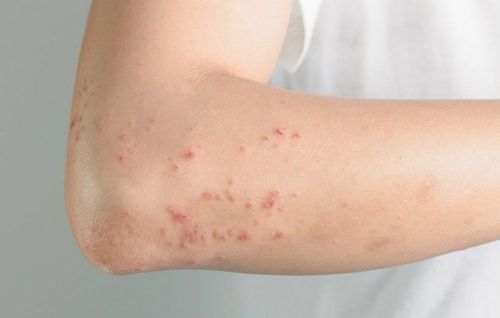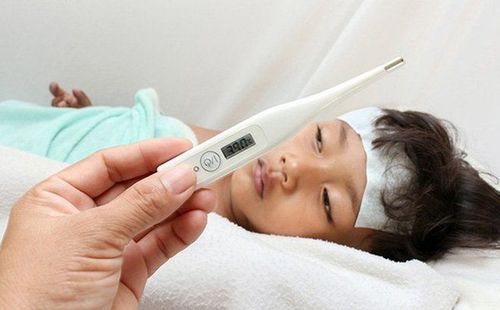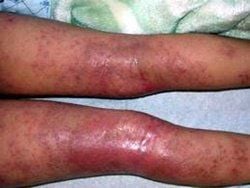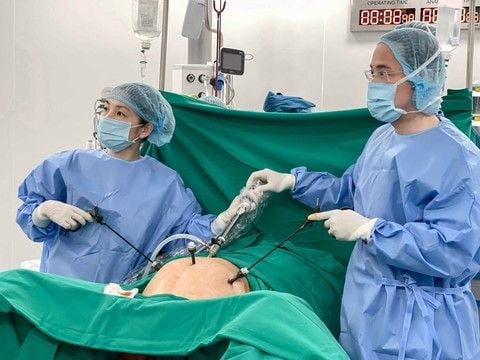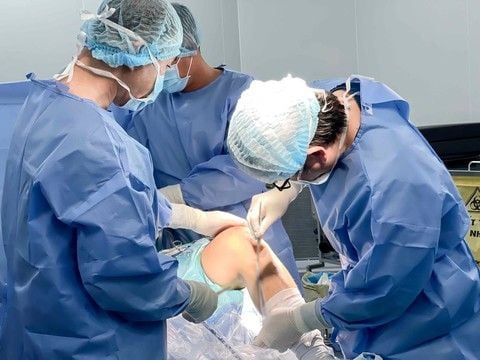This article is professionally reviewed by Master, Doctor Nguyễn Thị Nhật - Infectious Disease Specialist - Department of Internal Medicine - Vinmec Hai Phong International General Hospital.
Hand, foot, and mouth disease is a rapidly spreading illness, with the potential to develop into severe complications such as meningitis and encephalitis, which can be fatal. Currently, there is no specific antiviral treatment available for this disease.
1. What is hand, foot, and mouth disease?
Hand, foot, and mouth disease is a contagious illness that is primarily spread from person to person through the digestive tract. It can affect anyone, but children under 5 years old are the most commonly affected, especially those under 3 years old.
Since the disease is caused by enteroviruses, the main sources of transmission are saliva, stool, and blister fluid from infected children, which can easily spread and cause outbreaks. The main causes of the disease are Enterovirus 71 (EV71) and Coxsackievirus A16.
The main symptoms of the disease are skin lesions and mucosal lesions in the form of blisters on the palms, soles, and oral mucosa. Patients with hand, foot, and mouth disease can get infected repeatedly because the disease does not provide permanent immunity. Additionally, the disease can be caused by various factors, so people who have had the disease before can get it again. If not treated promptly, the disease can lead to serious complications such as encephalitis, meningitis, and pulmonary edema, which can result in death.
2. Symptoms of hand, foot, and mouth disease
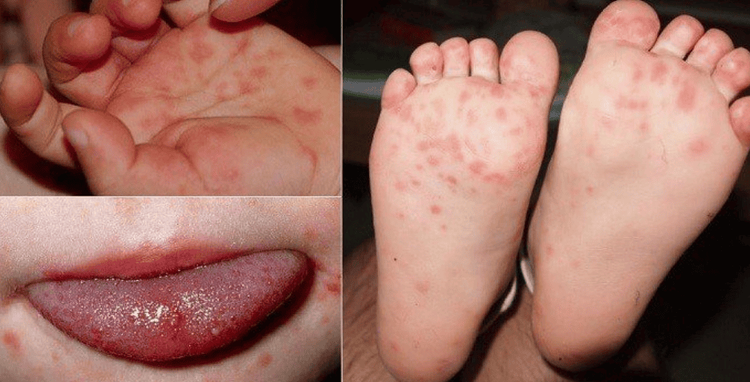
Common symptoms of hand, foot, and mouth disease include:
- Fatigue, loss of appetite, and frequent sore throat.
- Fever.
- After the initial stage, the disease shows signs of mouth pain, red spots that turn into ulcers, and ulcers may appear on the tongue.
- Skin rash.
- Some patients with hand, foot, and mouth disease may have no symptoms, or only show a rash and mouth ulcers.
- Blisters appear, usually ranging from 2-10mm in size, oval-shaped, grey in color, commonly found on the palms, soles, buttocks, and knees. Blisters may also appear in the mouth, and when these blisters burst, they cause pain due to mouth ulcers, leading to children losing appetite or refusing to eat. After about 5-7 days, the blisters will deflate and heal on their own. Children may experience vomiting and diarrhea after the blisters appear or after they deflate.
3. Signs indicating complications of hand, foot, and mouth disease
Hand, foot, and mouth disease often resolves on its own and does not threaten the patient's health, but it can cause extremely dangerous complications.
Some signs indicating potential complications of hand, foot, and mouth disease include:
- Persistent high fever
- Continuous high fever for many days (over 2 days) above 39°C
- Frequent vomiting without diarrhea, vomiting not following a cough
- Children who are often irritable, easily startled
- Elevated white blood cell count, above 16000/mm³
- Increased blood sugar levels
- Difficulty breathing, stridor
- Increase in basic skin lesions If any of these signs appear, take the child to a specialized hospital immediately
If any of the above signs appear, the child should be taken to a specialized hospital immediately for timely treatment to avoid dangerous complications.
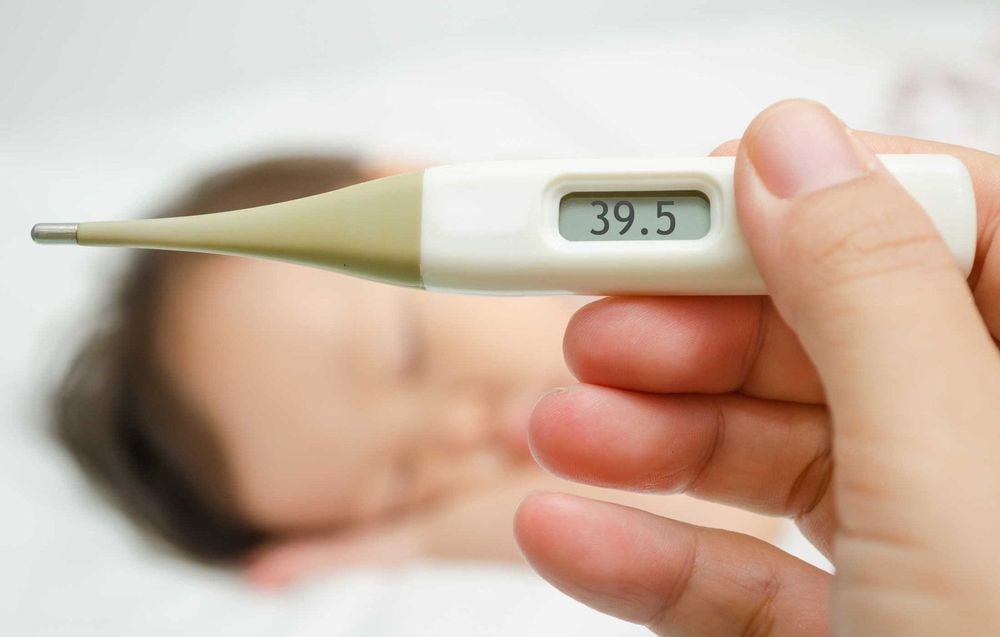
4. Risk of Misdiagnosis of Hand, Foot, and Mouth Disease
Hand, foot, and mouth disease can have various complications, leading to its confusion with other illnesses such as:
- Pneumonia, acute laryngitis: patients with hand, foot, and mouth disease may exhibit symptoms like rapid breathing, shortness of breath, along with wheezing or stridor
- Sepsis, septic shock: patients with hand, foot, and mouth disease are at risk for complications with high fever and shock
- Bacterial meningitis
- Rabies: characterized by agitation, screaming. This can also be a complication of hand, foot, and mouth disease.
Hand, foot, and mouth disease often progresses rapidly; if not treated promptly, it can threaten the child's life.
5. How to handle hand, foot, and mouth disease

So far, there is no specific treatment for hand, foot, and mouth disease. Therefore, patients with hand, foot, and mouth disease need to be closely monitored and the disease should be detected early. If any signs of the disease appear, the patient should go to a reputable medical facility for timely treatment.
In addition, patients should also drink plenty of water, supplement with adequate nutrients and exercise regularly to increase the body's resistance, improve the immune system to fight against the negative effects caused by the disease such as ulcers, high fever, and prevent and limit dangerous complications of the disease.
Hand, foot, and mouth disease can spread rapidly and cause dangerous complications, so it is essential for patients to be vigilant and promptly recognize any signs of the disease. Especially for young children, parents need to be attentive and monitor for signs of worsening conditions.
The Pediatrics Department at Vinmec International General Hospital is a reliable place for examining and treating diseases that infants and young children are prone to, such as viral fever, bacterial fever, otitis media, pneumonia in children, etc. With modern equipment and a sterile environment, the risk of disease transmission is minimized. Additionally, experienced pediatricians provide dedicated care, making medical examinations less of a concern for parents.
Master, Doctor Nguyễn Thị Nhật has over 10 years of experience in the field of artificial kidney and infectious diseases, examining and managing patients with kidney disease and infectious diseases. Currently, she is an Infectious Disease Specialist at the Department of Internal Medicine, Vinmec Hai Phong International General Hospital.
Please dial HOTLINE for more information or register for an appointment HERE. Download MyVinmec app to make appointments faster and to manage your bookings easily.
To arrange an appointment, please call HOTLINE or make your reservation directly HERE. You may also download the MyVinmec app to schedule appointments faster and manage your reservations more conveniently.


